Recent Articles
Popular Makes
Body Types
Chevrolet Camaro Retrospective
35 years of power, performance, and style

Arriving four years late to the pony car party, the 1967 Chevrolet Camaro was rushed into production after Ford’s stunning success with the original Mustang. Now, 40 years later, history repeats itself. With nearly 200,000 Ford Mustangs sold after a 2005 retro redesign took the icon back to its 1960s roots, Chevrolet can’t afford to ignore the sporty rear-drive coupe segment, and the bowtie boys are planning a return as evidenced by the Camaro concept car the company trotted out at the 2006 North American International Auto Show which foreshadows a production car to arrive for 2009. When the new Chevy Camaro hits showrooms, Ford will have added power, performance, and polish to the successful Mustang. Will General Motors be too late this time, or will the return of the Camaro, and the Dodge Challenger, spark a new pony car war to rival the late 1960s and early 1970s? With Baby Boomers retiring with more wealth than any generation in history, we forecast a long and successful run for these retro-modern muscle cars. And if the Camaro Concept piques your interest, you might want to know a little bit more about this legendary performance machine, so turn the page for a retrospective on the iconic Chevy Camaro.
1967 – Pacing the Race
Aimed right at the popular Ford Mustang, the 1967 Chevrolet Camaro mustered more than 220,000 sales in its debut year. Chevrolet offered the Camaro as a hardtop coupe or a soft-top convertible, in standard, Rally Sport (RS), Super Sport (SS), and Z28 trims. The standard engine was a 140-horsepower, 230 cubic-inch inline six-cylinder engine, and an upgrade V8 motor made 210 horsepower from 327 cubes. Optional engines included a 155-horse 250 inline six, a 275-horse 327 V8, a 290-horse 302 V8 for the limited-production Z28 (rumored to actually make more like 400 horsepower), a 295-horse 350 V8 (the venerable small-block Chevy V8 engine), a 325-horse 396 V8, and a 375-horse 396 V8. Ah, the good old days. A three-speed manual was standard, a four-speed manual was optional, and the six-cylinder model could be paired with a two-speed Powerglide automatic. An automatic transmission was also offered with the 396 cid V8 making 325 hp. The ’67 Chevy Camaro paced the Indianapolis 500 race that year, and just 100 replicas like the car shown above were built.
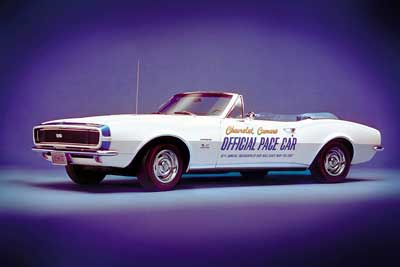
1968 – Success!
In 1968, the Chevy Camaro proved itself popular with consumer – and racers. Ironically, the Camaro won the Trans-Am championship that year, not its corporate sibling the Pontiac Firebird, which famously wore the “Trans-Am” name for decades starting in 1969. The performance-oriented Z28 model was more widely available, and minor cosmetic changes inside and out marked the 1968 Camaro. Optional four-wheel-disc brakes also debuted in the middle of the model year.
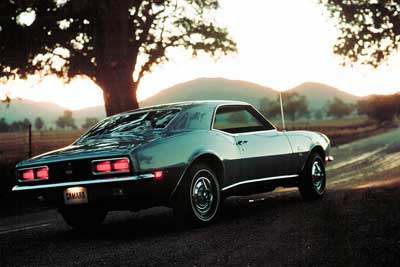
1969 – Last Original
Updated styling for 1969 created one of the best-looking Camaros ever, with revised fenders and quarter panels, updated front and rear styling, and a new dashboard. The look lasted one year, and the ’69 Chevy Camaro convertible was the last one for almost two decades. The Camaro paced the Indianapolis 500 again, and won the Trans-Am racing championship one more time. Z28 models equipped with the high-revving 302 V8 got a more realistic horsepower rating of 350 ponies. The 1969 Chevrolet Camaro coupes enjoyed an extended run as early-1970 models because the redesigned second-generation model was delayed until February of 1970.
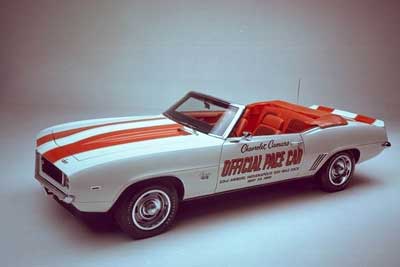
1970 – New Generation
After just three years on the market, the Chevy Camaro was completely redesigned, adopting a European appearance with a very long hood and a very short deck. Inside, the ’70 Camaro sported driver-centric cockpit-style instrumentation, and a “stirrup” shifter with the optional automatic transmission. The convertible model was dead, and Camaro coupes were sold in standard, RS, SS, and Z28 trim. The RS received special styling cues like a split front chrome bumper, inboard parking lamps, and hidden wiper blades. The base engine was a 155-horsepower, 250-cid inline six-cylinder. A 200-horsepower, 307-cid V8 was available as an option. A 250-horse 350 V8, a 300-horse 350 V8, a 360-horse 350 V8 (for Z28 only), a 350-horse 396 V8*, and a 375-horse 396 V8* were also offered. An automatic transmission was available on the Camaro Z28 for the first time in 1970. * Actual displacement was 402 cubic inches.
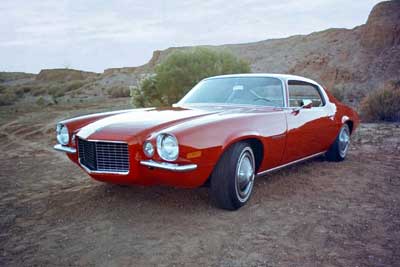
1971 – Power Slide
Groovy new vinyl top options debuted on the 1971 Chevy Camaro, and new standard features like power front disc brakes and a defroster arrived. The ’71 Camaro SS, shown here, included fake wire wheel covers, white-lettered tires, a dual exhaust system, and a right-side sport mirror. The big news for 1971, however, was that power ratings took a tumble. The standard six-cylinder motor lost 10 horsepower, while the Z28’s 350 V8 took a 30-horse hit and the mighty 396 motors dropped 50 ponies. These horsepower reductions occurred before the switch from gross to net ratings: in 1972, the most powerful Camaro Z28 made just 255 horsepower.
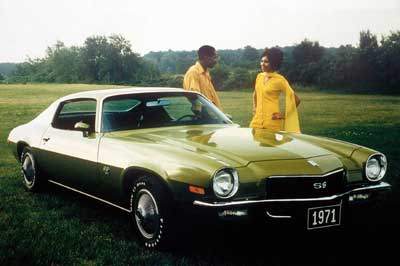
1974 – Regulated by USA
For 1974, the Chevy Camaro was restyled with federally-mandated five-mph bumpers and new sheetmetal. At the rear, the Camaro’s round quad taillights gave way to a new trapezoidal wrap-around design that would characterize Camaro styling until the end of the line. With a new cultural emphasis on “personal luxury,” the zooted-up Camaro Type LT (Luxury Touring) debuted to tremendous success, slotting in between the standard model and the Z28 performance edition. The standard engine was a smog-strangled inline six making a measly 100 horsepower. Optional 350-cid V8s offered 145, 160, or 185 horsepower. The ’74 Camaro Z28, pictured here, got a gaudy hood graphic and a 245-horse 350 V8.
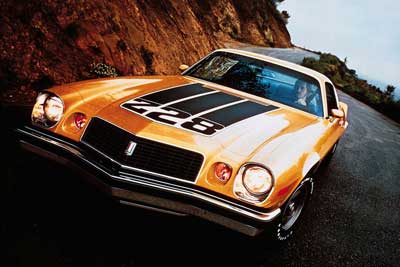
1975 – Z28 is Dead
The Camaro Z28 was gone for 1975, replaced by a revived Rally Sport trim level. Stylistically, the 1975 Chevy Camaro received a new wrap-around rear window for improved visibility. The standard six-cylinder engine gained five horsepower this year, but the most powerful Camaro sold for ’75 was equipped with a pathetic 155-horsepower 350 V8, and that engine was only offered in California and high-altitude regions. Other Camaro buyers got stuck with a 145-horsepower version of the 350. Shown here is the luxed-up Camaro Type LT.
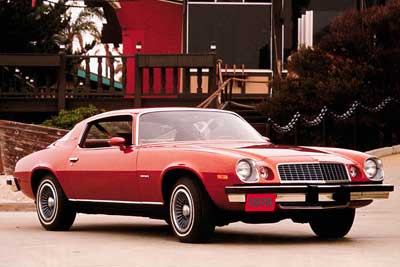
1976 – Paint and Stripes
Paint and stripes were about the only excitement offered with the emasculated 1976 Chevy Camaro lineup, even though engineers were learning how to extract more horsepower out of the embarassing engine lineup. The optional 350 V8 was making 165 horsepower in 1976, and a new 305-cid V8 for the Type LT whipped up 140 ponies. Ten new paint colors were offered for 1976, and the vinyl roof option only covered the front half of the roof, leaving a body-colored band of metal stretching between the B-pillars.
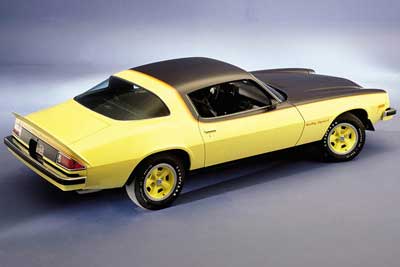
1977 – Overshadowed
Burt Reynolds drove a 1977 Pontiac Firebird Trans-Am to fame in “Smokey and the Bandit,” one of the great car-chase movies of all time, leaving the revived Camaro Z28 overshadowed by its corporate twin for years. The Z28 received a stiffer suspension, painted rally wheels, fatter tires, quicker steering, a big decklid spoiler, special graphics, and a dual-resonator exhaust system. It even got a 185-horsepower 350 V8. But most people preferred to have a screaming chicken decal on the hood of their GM-built sport coupe.
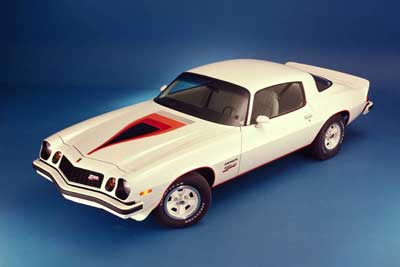
1978 – Restyled
Refreshed for the second time, the 1978 Chevy Camaro lent new life to a rapidly aging design. The biggest change was a switch from metal bumpers to soft urethane front and rear fascias painted the same color as the body, but snazzy new T-tops that rattled and leaked were also notable. Standard, Type LT, Rally Sport, and Z28 trim levels continued, and the Z28 got a fake hood scoop and fender vents to better battle the incredibly popular Firebird Trans-Am. Buyers in California could only get a Camaro with an automatic transmission in 1978. The engine lineup remained the same, though the optional 350 V8 for all Camaros except the Z28 was making 170 horsepower by now. Watch out.
